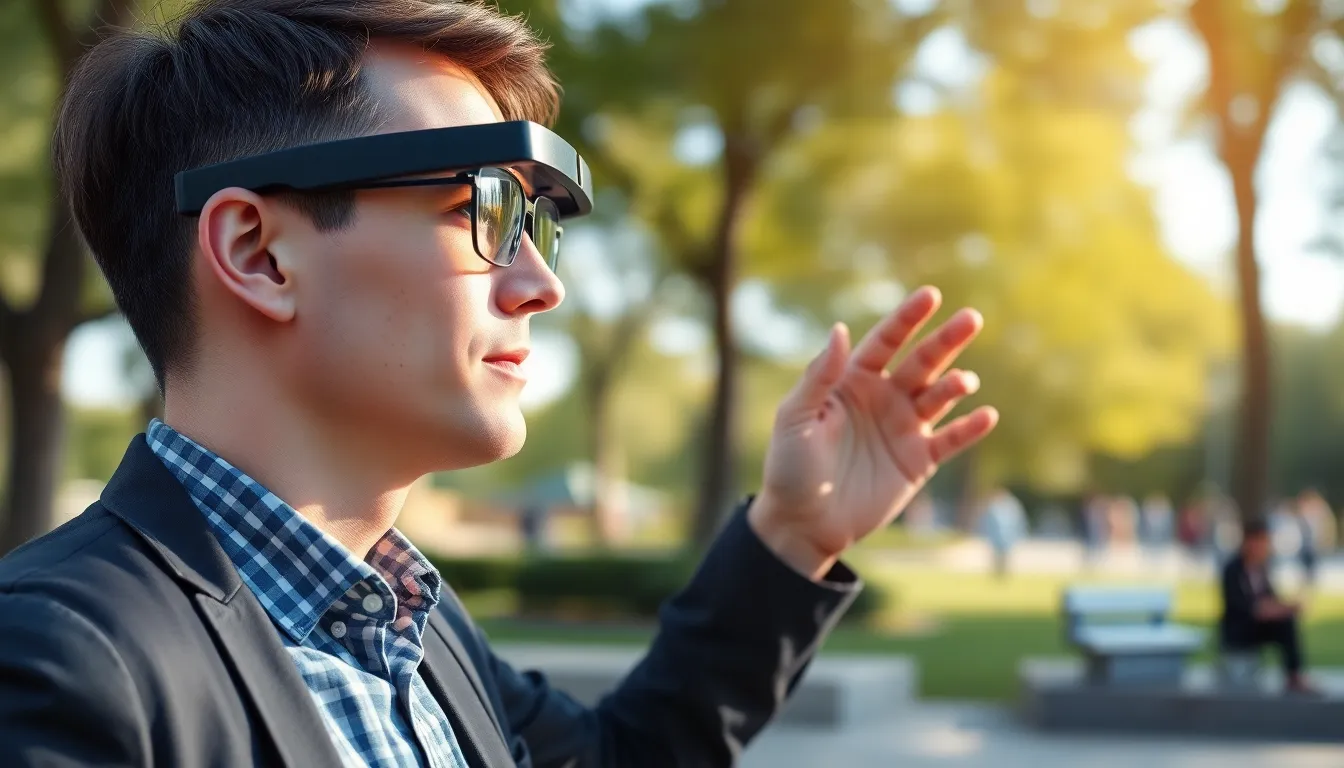Imagine a world where your glasses do more than just help you see. Enter smart glasses, the futuristic eyewear that’s poised to revolutionize how we interact with technology. These nifty gadgets are not just for the tech-savvy; they’re for anyone who wants to elevate their everyday experience. From hands-free navigation to augmented reality gaming, smart glasses are turning heads—literally.
Table of Contents
ToggleOverview of Smart Glasses
Smart glasses empower users by integrating digital information with the physical world. These devices provide features such as augmented reality, navigation, and hands-free communication. Enhancements include displaying notifications, maps, and even social media updates directly in the line of sight.
Such functionality targets diverse users. Gamers experience immersive gameplay through augmented reality features, while professionals can access productivity tools without distraction. Improved sensors and cameras capture real-time data, further enriching user experience.
Examples of smart glasses include Google Glass and Microsoft HoloLens. These products demonstrate extensive capabilities, from voice commands to visual overlays, enhancing various activities. Moreover, research indicates that the global smart glasses market could reach approximately 2.5 billion dollars by 2024.
Adoption trends continue to rise, especially as technology advances. Increased interest from manufacturers leads to innovative designs and functionalities. Improved battery life and lightweight materials ensure comfort for extended use. The combination of real-world utility and cutting-edge technology positions smart glasses as a significant player in wearable tech.
With smartphone integration, users can seamlessly connect smart glasses to their devices. Data synchronicity becomes effortless, enhancing overall functionality. As the market evolves, potential applications in healthcare, education, and entertainment expand.
Unquestionably, smart glasses represent a forward leap in technology, pushing boundaries and shaping future interactions. Their versatility opens doors for industries, making everyday activities more efficient and engaging.
Key Features of Smart Glasses

Smart glasses incorporate advanced technology, enhancing user interaction with the digital world. Key features like display technology and user interface significantly improve the overall experience.
Display Technology
Display technology in smart glasses varies among models, leveraging cutting-edge innovations. Transparent lenses allow users to view digital content without obstructing their surroundings. OLED and MicroLED screens provide vivid colors and sharp resolutions, enhancing visual clarity. Many smart glasses also feature augmented reality capabilities, merging virtual elements with reality for immersive experiences. Manufacturers prioritize lightweight designs to ensure comfort during prolonged use, making wearability a crucial factor. Enhanced brightness functions accommodate diverse lighting conditions, aiding visibility outdoors.
User Interface
User interfaces for smart glasses focus on intuitive navigation and ease of use. Touch-sensitive controls allow users to interact with virtual elements seamlessly. Voice recognition enhances functionality, enabling hands-free commands and ensuring a less distracted experience. Gesture controls, including swipes and taps, further simplify user interactions. Many models integrate compatibility with smartphones, facilitating notifications and app management. Customizable settings enhance user preferences, empowering individuals to tailor experiences according to their needs. Feedback mechanisms provide users with context-aware assistance, promoting engagement with digital environments effectively.
Benefits of Smart Glasses
Smart glasses offer numerous advantages, enhancing daily lives through technology integration. Users experience significant improvements in various aspects, including productivity and augmented reality applications.
Enhanced Productivity
Hands-free communication boosts efficiency. Users can manage tasks and receive notifications without diverting attention from their activities. Smart glasses enable streamlined access to important information, such as work emails or meeting reminders, directly in the user’s line of sight. Voice recognition and gesture controls simplify interactions, allowing for quick task management. Increased multitasking possibilities facilitate better time management, helping professionals achieve more throughout the day. As a result, productivity rises across different fields, from healthcare to logistics.
Augmented Reality Applications
Augmented reality transforms the way users interact with their environments using smart glasses. Visual overlays enhance experiences in gaming, navigation, and training. For example, navigation systems display route information directly on the lens, granting users hands-free directions while on the go. In education, interactive presentations engage students by merging digital content with real-world visuals. Additionally, industries like manufacturing leverage augmented reality for training and maintenance, reducing errors and improving efficiency. Smart glasses thus offer powerful applications that redefine user engagement in various sectors.
Challenges and Limitations
Smart glasses face various challenges and limitations that impact their widespread adoption. One major concern revolves around privacy.
Privacy Concerns
Privacy concerns frequently arise with smart glasses due to their built-in cameras and recording capabilities. Users and bystanders may feel uncomfortable with the potential for unauthorized recording in public spaces. Misuse of this technology for spying poses ethical issues, prompting questions regarding consent and personal privacy. Regulatory frameworks often struggle to keep pace with the rapid evolution of smart eyewear. Manufacturers must address these privacy challenges to build trust among potential users. Ensuring transparency about data collection practices can help mitigate concerns.
Battery Life Issues
Battery life remains a crucial hurdle for smart glasses, affecting user experience significantly. Many models struggle to sustain power during prolonged use, limiting their practicality. Users often face frequent charging sessions, which can disrupt workflows. Advanced applications, like augmented reality, further drain battery resources quickly. As users demand longer-lasting devices, manufacturers must invest in more efficient batteries and energy management systems. Innovations in battery technology, such as solid-state batteries, could enhance longevity and performance. Addressing battery life will play a vital role in making smart glasses more appealing to a broader audience.
Popular Smart Glasses on the Market
Smart glasses have captured consumer attention, showcasing a variety of products with unique features and functionalities. This section highlights notable products in the market.
Product A
Google Glass Enterprise Edition 2 stands at the forefront of smart glasses technology. This device targets professionals across various industries, particularly within manufacturing and healthcare. Equipped with a high-resolution display, it overlays critical information onto the user’s field of vision. Voice commands facilitate hands-free operation, enhancing convenience and productivity. Integrated Android software supports custom applications tailored to specific workflows, improving efficiency on the job. The robust design ensures durability in demanding environments while allowing continuous connectivity with smartphones. In early 2023, reports indicated that Google Glass Enterprise Edition 2 reached sales figures surpassing 1 million units globally, highlighting its widespread adoption.
Product B
Vuzix Blade ups the ante with its sleek design and advanced features aimed at tech-savvy consumers and professionals. This model incorporates a see-through display, which showcases real-time notifications and navigation instructions. With a camera featuring augmented reality capabilities, users can capture images and videos while interacting with their surroundings. Enhanced Wi-Fi connectivity allows for seamless access to web applications and services. Vuzix Blade optimizes user engagement through touch controls on the side of the glasses, while voice recognition further streamlines navigation. By mid-2023, Vuzix announced substantial partnerships with various enterprises, suggesting a growing interest in augmented reality solutions among industries.
Smart glasses are transforming how users interact with technology and their surroundings. By seamlessly integrating digital information into daily life, they offer unique functionalities that cater to a diverse audience. As advancements continue, the potential applications across various industries promise to enhance productivity and user engagement.
Despite challenges like privacy concerns and battery limitations, the market for smart glasses is poised for growth. Innovations in design and technology will likely address these hurdles, making smart glasses more accessible and appealing. As they evolve, these devices will undoubtedly shape the future of wearable technology and redefine user experiences in ways previously imagined.



